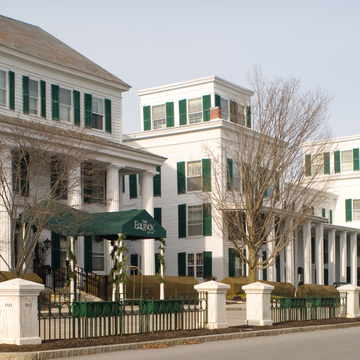The cohesive Greek Revival townscape that is the core of Manchester village is the result of a process of expansion and amalgamation by the Equinox, one of America's great nineteenth-century resort hotels. Its colonnaded main facade is composed of four connected buildings. The southernmost pair developed as Vanderlip's Hotel in 1839 when Martin Vanderlip remodeled an 1801 Federal tavern with a colossal Greek Revival portico of fluted Doric columns. With the arrival in 1852 of the railroad, which introduced a New York clientele to Manchester's clean air and beautiful setting, Vanderlip turned his stagecoach inn and courthouse hostelry into a destination resort. In 1854 he added a third story and appended a three-and-a-half-story gable-fronted annex with matching colonnade to the south. Meanwhile, just to the north, Franklin Orvis developed a competing hotel with the assistance of Manchester Center master builder Aaron Sheldon, a notable Bennington County Greek Revivalist. In 1853 Sheldon remodeled a brick store (1834) and house (1832) with clapboarded facings, full third floors, and large belvederes, binding them together with a continuous grand portico of two-story square paneled columns. Orvis named the resulting complex the Equinox. Across Main Street, Orvis combined another four buildings, including the original county courthouse, into the Equinox Junior, for a total of one hundred and twenty-five rooms. Amenities of his resort included a music hall, bowling alley, trout pond, livery stables, croquet, lawn tennis, a carriage road to an outlook atop Mount Equinox, and a spring water bottling plant. In 1880 he acquired the Vanderlip (then known as the Taconic), joining its seventy-five rooms to his complex with a bridge (demolished in 1985). By the 1890s there was a golf course and, in 1915, a splendid new dining room.
For more than half a century the Equinox welcomed such guests as Mary Todd Lincoln and her sons Tad and Robert; Julia Dent Grant, wife of Ulysses S. Grant; Theodore Roosevelt; and William Howard Taft, but by the Great Depression the hotel was in trouble. After several decades of bankruptcy and changing ownership, the hotel slipped into foreclosure in the 1970s and shut its doors. As the Equinox became an increasingly decrepit pile, the community sought ways to revive the landmark and save their village. In the 1980s, the growth of winter sports enhanced the feasibility of year-round operation and in 1984 investors with the aid of an urban development grant began a restoration. The resurrected Equinox reopened in July 1985, the result of a triumphant collaboration between investors, preservationists, the state, and the local community. The Equinox survives as one of the nation's great historic hotels, conserving a sense of the world of Victorian summer resorts and preserving a distinctive Greek Revival townscape that is unique in the nation.







